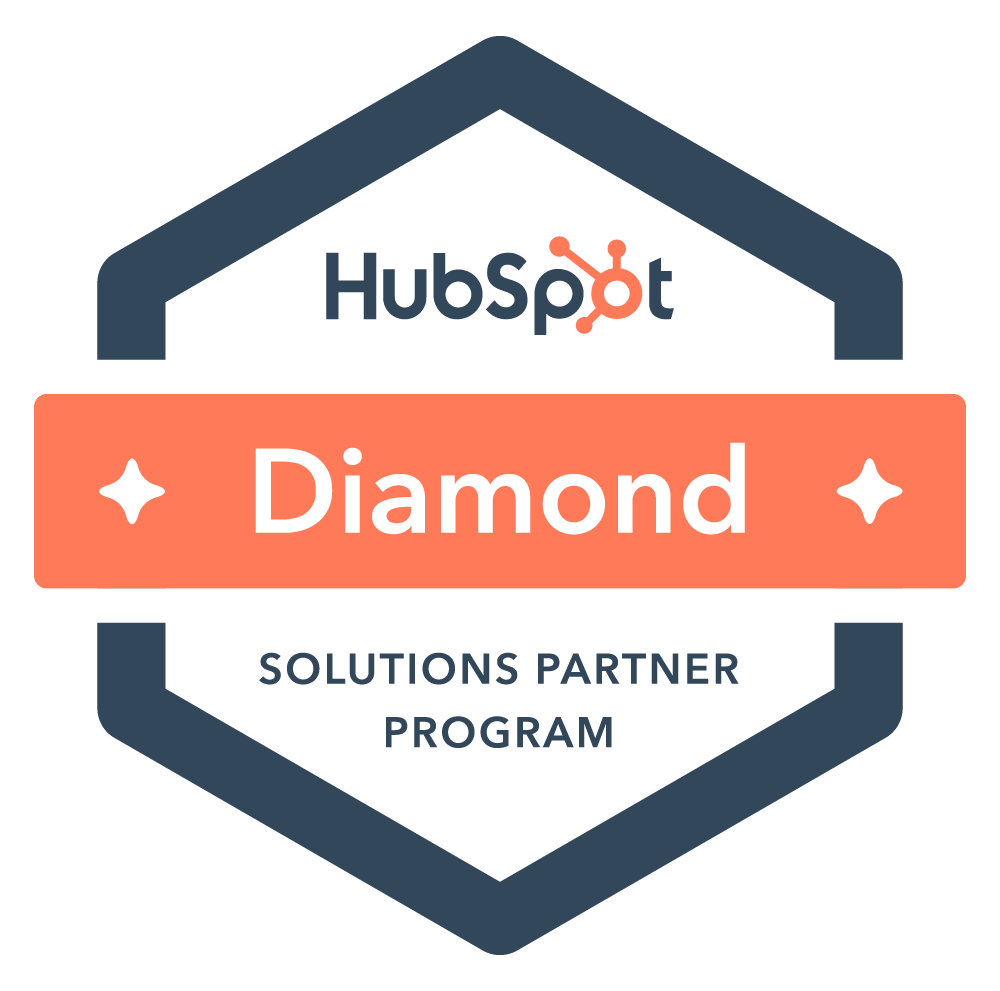-
Digital Marketing
We help you to use your digital potential. For a strong positioning, more visibility and more leads.
Sales Enablement
Targeted customer acquisition for more sales. Identify, target and close the right leads.
Get Growth ready
With the BEE.Transformance model, we bring continuous and profitable growth to your company. A new mindset for your team.
Industries
We transform your challenges into opportunities through the experience we have gained from projects in these industries.
-
HubSpot Services
As a HubSpot Diamond Partner, we help you implement your digital growth strategy with a focus on performance - by implementing and integrating new and existing systems as well as 3rd party apps.
HubSpot Thought Leader
As a HubSpot Diamond Partner with +50 certifications, host of the HubSpot User Group Zurich, HubSpot Trainer and HuSpot User Champions, you have access to in-depth HubSpot expertise.
HubSpot Solutions
The BEE.Theme offers you more creative freedom than any other theme on the market. Whether you're a beginner or a professional, a creative mind or a digital agency - with the BEE theme, you can easily unleash the maximum power for your pages in HubSpot CMS.
-
BEE.Blog
Knowledge around digital marketing, digital sales, technology, data intelligence and employees.
Knowledge Base
Pure knowledge: everything essential concentrated, compact, digitally prepared for you and ready to download.
What is inbound?
The most effective way to successfully combine digital marketing and digital sales.
-
BEE.Team
The BEE.Performers: many different characters - with one thing in common: the fascination for a digital world.
References
More than 100 large and small companies have already started with BEE: to more visibility, more performance, more growth.
Invest
Participate in the growth of BEE and become part of the BEE Growth Story by purchasing Digital Share Tokens.
We're hiring
Become a BEE.Performer! Are you ready for your own transformation?
Inbound Marketing
But there is much more to it.
Find out everything on this page!
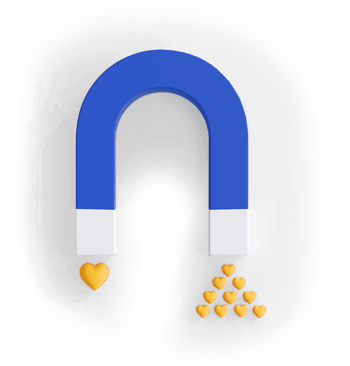
This guide describes the proven most efficient marketing method that can fundamentally change your marketing and bring you more enthusiastic customers in the long term. Get to know this unique method and familiarise yourself with all its concrete steps, activities and tools for its implementation. This inbound marketing manual offers you a comprehensive and in-depth introduction to this fascinating topic. You are welcome to download it free of charge as a PDF or contact us with any questions or uncertainties. After reading this, your understanding of marketing will be completely different.
- What is inbound marketing?
- Introduction
- Inbound vs. outbound marketing
- How did inbound marketing come into being?
- Inbound vs. content marketing
- What is a buyer persona?
- What is a customer`s journey?
- How does the inbound marketing methodology work?
- Activities & Tools
- Excursus: From the sales funnel to the flywheel
- What is an inbound marketing campaign?
- What is an inbound marketing strategy?
- Summary
What is inbound marketing?
Inbound marketing is about drawing potential customers' attention to your company with relevant and helpful content and offering them added value throughout the entire buyer's journey. If possible, this added value is offered through various channels, such as the company website, a blog, and via social media.
Inbound marketing puts the (potential) customer at the centre. With valuable content, which is intended to help them solve their problems and challenges, the provider is there to advise and support them. The provider does not impose itself on the customer, but rather offers potential customers the opportunity to interact with the company at their own request, via chat, e-mail, landing page, etc. The customer can then contact the provider by email.
Introduction
According to the inbound marketing methodology: potential customers should find a company organically. They can then be converted into interested parties and finally acquired and retained as customers.
Inbound marketing puts the (potential) customer at the centre. With valuable content, which is intended to help them solve their problems and challenges, the provider is there to advise and support them.
So inbound marketing is about so much more than just customer acquisition. Through inbound marketing, communication between your company and stakeholders becomes more empathetic, human, and personal. It’s not about cool hacks, magic tricks, the latest hype or the best mix. Inbound marketing relies on a holistic and thoughtful approach to all customer acquisition activities. .
By following this methodology, you can achieve an authentic and mutually appreciative relationship that’s enriching to both the company and the customer.
Inbound vs. outbound marketing
In contrast to inbound marketing, classic outbound marketing focuses on sending one-sided advertising messages that are targeted at a very broad audience. This outreach is often perceived as annoying and relies on advertising mediums such as direct mail, radio commercials, TV commercials, flyers, spam and telemarketing. Using special advertising language, the aim is to convince as many consumers as possible of the benefits of a product or service in order to trigger as immediate a purchase as possible. Outbound marketing thus focuses on the short-term company-centred goal of selling a product and the associated increase in sales.
In inbound marketing, this buying action also plays an important role. But not exclusively. Because at the same time, all important aspects and processes before and after the purchase action are included. The potential customer and his needs are given a central role, and every marketing activity is geared towards them. The prospective customer, who usually became aware of the company via search engines or social media, is already provided with a certain value in the form of informative and entertaining content before the desired purchase action, but only with his permission. As a result, the aim is interactive and reciprocal communication, which ultimately leads to a purchase action and ideally a long-term relationship.
Inbound marketing
- 1.interactive and two-way communication
- 2.customer-centric
- 3.provides value
- 4.Informative and entertaining
- 5.Customers come via search engine, social media and links
- 6.Content is King
- 7.Effective in the long term
- 8.Dependent on permission of the recipient
Outbound marketing
- 1.one-way communication
- 2.company-centric
- 3.does not provide value
- 4.Selling
- 5.Customers come via print ads, TV ads, radio ads, web banners or phone ads
- 6.Budget is King
- 7.Short term effect
- 8.Has a disruptive effect on the recipient
Facts & Figures: Inbound vs. outbound marketing
33% of inbound marketers and 31% of outbound marketers consider outbound marketing with measures such as paid advertising to be a waste of resources and timet (source).Compared to traditional outbound marketing, inbound marketing costs 62% less per lead (source).32% of companies want to cut costs for outbound marketing and increase the budget for inbound marketing (source).
How did inbound marketing come into being?
Consumers have also grown up with the Internet. They have become much more active and self-confident in their research and purchasing habits. They are informing themselves intensively about all available products/services and their advantages and disadvantages before making a purchase.
Classic advertising is receiving less and less attention, especially on the Internet, and can even be completely hidden with the right tools. In turn, search engines such as Google and social media platforms such as Facebook, Twitter and LinkedIn are becoming much more relevant. To cope with this new situation, new strategies and tools were increasingly used in the marketing industry.
HubSpot publishes the latest figures on the "State of Inbound" once a year. Here, you can find the latest marketing and sales trends for 2020.
Facts & Figures: Genesis
B2B sales cycles are taking an increasingly long time and their complexity is steadily increasing. 58% of respondents confirm this - they state that the decision-making process has lengthened (source).
Inbound vs. content marketing
There is no question that inbound marketing and content marketing have a lot in common. For example, content is considered the heart and fuel of both types. But inbound marketing is even broader than content marketing. Successful guidance through the buyer's journey requires the use of other techniques such as SEO and social media. Therefore, content marketing can be seen as a subset of inbound marketing.
Facts & Figures: Inbound vs. content marketing
Front-office professionals from marketing, sales, and services see content marketing as a subset of inbound marketing (source).
What is a buyer persona?
At the beginning of any inbound marketing strategy is the buyer persona. This concept makes it easier for your company to better understand your customers, which means that content can be more precisely tailored to them and optimised. The buyer's journey (all the steps of the purchase decision process that a customer goes through) is particularly useful as a guide. This is because your customers only pay attention to your content if it is of interest and relevance to them. Most content, such as blog articles, is written intuitively and unconsciously for the buyer persona. However, by addressing them in a more targeted way, the content can gain more traction and value.
The concept of a target audience is also often used to define potential customers. The target group is a subset of an overall market whose members share one or more characteristics such as age, income or education. However, apart from these commonalities, the individuals in the target group are quite different. So with a target group, a market is narrowed down based on a few criteria. With buyer personas, on the other hand, a vivid and accurate picture of each customer persona is drawn.
Information about buyer personas can be obtained, for example, from interviews with existing customers or from market research. HubSpot's “Make My Persona” tool can help you create your buyer personas.
Facts & Figures: Buyer Persona
Of those companies that exceeded their lead and revenue goals, 71% documented their buyer personas (source).
What is a customer journey?
The Customer's Journey is usually roughly divided into the following steps:
- Awareness phase: the buyer recognises that he has a problem or need.
- Consideration phase: The buyer defines his problem or need and looks for general ways to solve the problem or meet the need.
- Decision phase: The buyer chooses a specific solution from a company.
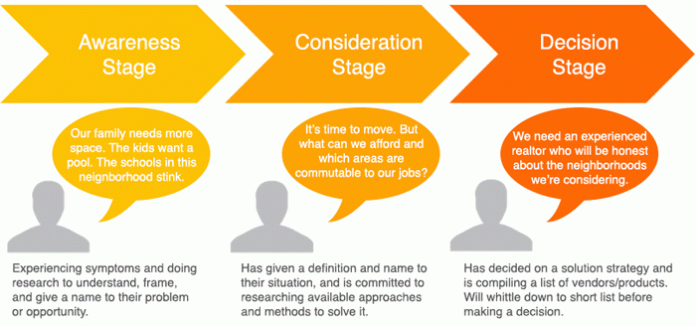
Facts & Figures: Customer`s journey
Integrating the Customer's Journey provides a competitive advantage and can increase sales by 100% year-on-year in some cases. This is proven by case studies (source).
How does the inbound marketing methodology work?
- Attract: The first step is to attract the right people at the right time with the right content. This is usually done via search engines like Google or social media platforms like Facebook.
- Interact (convert and close): In the second step, the visitor sends the company his contact data via a form and subsequently receives a counter value, such as an ebook. The visitor, who is now a lead, is now sent further helpful content, mainly via email. The frequent sending of valuable content generates attention and trust.
- Inspire: Once the contact has been successfully converted to a customer, it is important to stay in touch with them, provide them with further relevant content, and build a long-term and mutually enriching relationship with them. With a little skill, the customer will eventually become a promoter and recommend the company and its products or services to others.
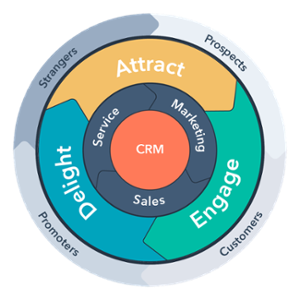
Ideally, inbound marketing is closely linked and coordinated with inbound sales and inbound customer service. Inbound sales and inbound customer service also go through the above-mentioned phases.
Facts & Figures: Method
70% of internet users don't want to learn about products through traditional ads, but through content (source).68% of online shoppers spend a lot of time engaging with content from a brand that interests them (source). When B2B customers first contact sales, they have already gone through 57% to 70% of their research (source). Compared to outbound marketing, properly executed inbound marketing is 10 times more effective at converting leads (source).No matter if B2B, B2C or Non Profit: the probability to achieve a higher ROI is 3 times higher with Inbound Marketing (source).Of the companies that use inbound marketing, 68% are convinced of the effectiveness of this marketing strategy (source).
Activities & Tools
The following table lists many possible activities as well as tools and assigns them to the respective phases in which they are most used.
|
ATTACH |
INTERAGENCIES |
INTERAGENCIES |
INSPIRE |
|
|
ACTIVITIES |
Inbound-Ready Website, Content-Marketing SEO Social-Media PR- & Ads-Marketing |
Lead generation High-quality content Videos Infographics Conversion Optimization |
Marketing automation Email marketing Inclusion of sales Lead scoring Lead nurturing |
Personalisation Community engagement Surveys WOW Service Touchpoint management |
|
TOOLS |
Blogging Platform Distribution Social media Keyword tracking |
FormulaCTAs Landing mages |
CRM Email marketing Workflows |
Survey Tool Smarter Content Social Monitoring |
It is not necessary to purchase new software for each tool. There are numerous complete solutions available on the market that combine several tools in one suite. These include HubSpot and Chimpify, for example.
Facts & Figures: Activities & Tools
A Swiss survey shows: 34.3% of respondents plan to introduce marketing automation within the next one to two years. 40% have not yet decided or have not yet familiarised themselves enough with the topic (source).
Excursus: From the sales funnel to the flywheel
The classic linear sales funnel with the phases Visitor / Prospect, Lead, Marketing Qualified Lead, Sales Qualified Lead, Opportunity, and Customer can only be applied to a limited extent to currently optimal sales processes. For this reason, the cyclical flywheel with the phases Attract, Interact, and Inspire is increasingly used in its place. Especially when it comes to inbound marketing. The flywheel is, therefore, a kind of inbound variant of the classic sales funnel.
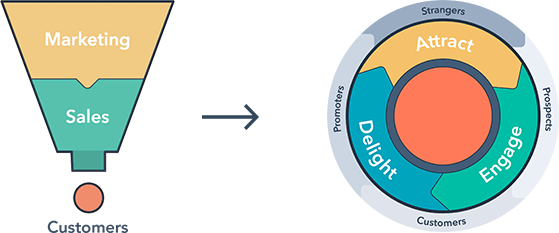
The energy that a customer brings with him does not dissipate in the flywheel – it is used for the further process, the further rotation of the wheel. The energy of a flywheel is particularly high when the process is fast, exposed to little friction, and the flywheel is as large and heavy as possible. But what does that mean exactly?
In order for the flywheel to turn quickly, a lot of force must be applied. This is achieved through a lot of effort by not only marketing and sales (as with the sales funnel), but also to after-sales service.
To ensure that the flywheel is exposed to little friction, good alignment is needed between the teams involved. Cross-divisional and holistic thinking, as well as harmonious cooperation, are essential. Recurring customer problems should definitely be discussed jointly among the teams.
The fast and smooth turning finally leads to more satisfied customers and makes the Flywheel bigger and heavier and gives it more and more energy. The satisfied customers stay loyal to the company and ideally still recruit new customers.
The flywheel goes through the phases Attract, Engage and Delight.
- Attract-Phase: In the Attract phase, the customer becomes aware of the company through valuable content via various channels such as social media, and an initial exchange takes place.
- Engage-Phase: In the Engage phase, the customer is supported before and after the sale through competent analyses and detailed exchanges, and the possible further steps resulting from this are proposed to him.
- Delight-Phase: The Delight phase ensures that the products and services used lead the customer – and thus, the company itself – to success. This phase is enormously important for the overall process.

Facts & Figures: Flywheel
Today, 57% of B2B buying processes are completed before buyers contact suppliers. In this process, buyers do not obtain information from suppliers' marketing materials, but make their decision based on other criteria: Websites with third-party reviews on, peer-to-peer recommendations, and word-of-mouth are playing a bigger role in buying decisions than ever before. At the same time, trust in companies as a whole is declining: 81% of shoppers trust recommendations from their families and friends more than business advice. 55% say they trust the companies they buy from less than they used to (source).
What is an inbound marketing campaign?
Inbound marketing campaigns are concerted efforts where all of your marketing channels are aligned around a single message and goal.
Every inbound marketing campaign starts with an offer, but not the actual product offer. Rather, the offer contains something valuable and relevant to your buyer persona, such as an ebook. This offer is promoted unobtrusively through your marketing channels.
Subsequently, the leads gained through this offer should be guided through the marketing funnel through effective lead nurturing that encourages them to remain your customers. Continuous measurement, analysis and optimisation of the inbound marketing campaign increases its success.
To ensure that your efforts don't go to waste, you should definitely compile your ideas into an inbound campaign plan.
Facts & Figures: Campaign
Regardless of marketing budget, companies are three times more likely to achieve a higher ROI with inbound marketing campaigns than with outbound marketing campaigns (source).
What is an inbound marketing strategy?
The inbound marketing strategy is derived directly from the corporate strategy and describes how your company conducts its marketing. It defines how the acquisition process described above should be implemented in your company.
A holistic inbound marketing strategy usually includes at least the following points:
- Audit: Through a comprehensive as-is analysis, the current website, inbound marketing measures, email marketing and SEO measures are put through their paces. The results are then compared with the competitors.
- Buyer persona: You find a buyer persona in your target groups and sub-target groups. It is primarily important to find out their problems, challenges, needs, questions and their online and offline locations.
- Core: The core of the strategy should be defined before concrete steps are planned. The design of the content hub, the vision, the goal and the positioning of your strategy should be clearly worked out.
- Structure: After you have clarified the basics of the inbound marketing strategy, you can determine the message, category, topics, editorial plan and sources.
- Channels: Promote your content by using marketing channels such as social media or PR.
- Funnel: When describing the funnel, you determine how your content will guide your buyer persona through the different stages of their purchase decision process.
- Key performance indicators (KPIs): Determining and regularly monitoring your KPIs is essential for the success of your strategy. The most important values that go into the KPIs are "visitors", "engagement", "leads", "email" and "customers".
- Team: In order to implement the inbound marketing process as smoothly as possible, each team member should be well acquainted with the process details. Owners, roles and workflows must be clearly defined and assigned.
- Guidelines: Every strategy should contain clearly defined guidelines that are continuously optimised. These serve as a reference for your employees, and they promote consistent communication.
Summary
Instead of focusing on the company and its success, inbound marketing is all about the (potential) customer and their needs, problems and challenges. Instead of using annoying and disruptive advertising to force customers to pay attention, the modern marketer focuses on valuable and relevant content that helps the prospect solve his problems. On the customer's side, initial interest is followed by increased interaction with the company, which ultimately does everything in its power to inspire them all around and accompany them on the road to success. Inbound marketing is not just a new hype, but a sustainable and efficient method of customer acquisition that has been proven to lead to more visitors, leads and customers. Try it out!
As mentioned above, you are welcome to receive this guide as a PDF. Just click on this button!
Get to know the most efficient marketing method
BEE is a digital growth solution partner
Transform to perform
For mid-market and corporates in the DACH Region that want to transform their business in order to grow locally and globally, BEE is the highest-ranked digital growth solution partner that combines strategy, execution, data intelligence and people in a transformance model.
What BEE stands for
BOOST performance
EXPAND growth
EXCEED expectations
